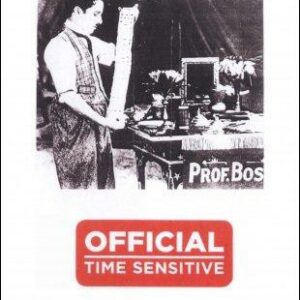Learn Magic is a classic magic book for serious beginners. It teaches 20 lessons and focuses not just on effects, tricks and moves, but also on the 'how to learn magic' aspect. Beautifully illustrated by Hans Jelinek.
Henry Hay's larger magic book for beginners, The Amateur Magician's Handbook is broader in scope and already assumes some basic knowledge about magic.
Paul Fleming wrote:
Some three or four years ago, we examined (in Review No. 19) a little book by Barrows Mussey, entitled Magic. The same author, writing under another name, has now given us a new treatise for beginners in conjuring which is not only larger but far more likely than his earlier book to make a competent performer of the reader.
This book, Learn Magic is a volume of 287 (viii +279) pages, illustrated with 92 figures. There are two preliminary chapters on how to watch and how to be a magician; twenty chapters (or "lessons"), six of which deal with cards, two each with coins, balls, and silk handkerchiefs, and one each with rope, thimbles, thumb-tips, escapes, mind-reading, eggs, tricks with cloth bands and turbans, and conjuring accessories such as tables, servantes, and the magic wand; and a final chapter on stage illusions.
As is suggested by the title, Learn Magic is not a book that was written for those who are already conjurers, unless they happen to be conjurers of the "magic shop" variety who think of magic in terms of handiwork of the tinsmith and cabinetmaker. To such unfortunate souls Mr. Hay's book may be strongly recommended as proof that a moderate amount of personal skill will produce vastly better magic than hundreds of dollars' worth of suspicious-looking apparatus. The well-read magician will already have learned this lesson – and, let us hope, profited by it. For him, the contents of Learn Magic will in the main be familiar material, for Mr. Hay – like Hoffmann, Sachs, Tarbell, Hugard, and other writers of general treatises -has naturally had recourse to the common stock of principles and feats that has been accumulating for many decades.
Hence, we find in this book such well-known tricks as The Afghan Bands (which in this form might well have been credited to James C. Wobensmith), The Turban Trick, The Sack Escape, The Egg Bag, "One Ahead" Mind Reading, The Rising Cards (three methods), The Torn and Restored Paper Strip, Handkerchief Production and Color-change, The Sympathetic Silks, The Miser's Dream, The Cards Up the Sleeve, The Sponge Balls, the Multiplying Billiard Balls, A Thimble Routine, and a host of other feats. There are, in addition, explanations of dozens of sleights with cards, coins, balls, and thimbles; of "codes" used in apparent thought-transference; of black-art tables, bottomless glasses, mirror glasses, and other kinds of conjuring equipment.
Indeed, we incline to the view that more ground has been staked out here than an author should attempt to cover in a volume of this size. We feel, too, that stage illusions should have been omitted, for two reasons: (1) because the space used could have been employed more advantageously in giving fuller explanations of tricks which the reader has some chance of being able to present, and (2) because there seems to be no good reason for giving the "general reader" – the specific audience to which Learn Magic is addressed – any knowledge, however superficial, of the principles employed in stage illusions. Mr. Hay's excuse for these exposures – to give the beginner "some basis for judging the illusionists" he sees – is pretty lame.
Drawing upon the experience of many years of professional performing, we question the soundness of some of the author's statements and the wisdom of some of the advice he offers the beginner. He says (p. 12) that it is best not to memorize patter, though such famous performers as Kellar, Germain, Powell, and Rouclere took pains to be letter-perfect in their lines. He writes (p. 17): "The fear of detection and the dropping of anything you practice with will go on as long as you do magic." This is certainly not true of a number of performers with whom we are acquainted. Nor is it true, as the author says (p. 6), that "things go wrong at every performance of every magician who ever lived." Some magicians unquestionably suffer from nervousness, and things do go wrong at times, but we see little to gain and much to lose by teaching that it is normal for performers to be fearful of detection and for things to go wrong. The magician for whom things habitually go wrong (who is also the one most likely to experience fear of detection) is almost certainly the careless performer, who has not given sufficient time to preliminary preparation or who undertakes to present new effects without proper rehearsal. We believe the beginner should be taught that slovenliness leads to disaster in conjuring, and that the magician who is a credit to his art is the one for whom things do not frequently go wrong!
In speaking of the use of confederates, Mr. Hay says (p. 70): "The only objection in my eyes is that you can't be ready at a moment's notice to do the trick (and that your stooge may not be much impressed with your powers as a magician)," completely ignoring the fact that both the confederate and the performer are dishonest with the audience – the former in bearing false witness and the latter in causing him to do so. He instructs the performer (p. 26) to hold a coin between his teeth (an act that can scarcely be recommended as being in good taste); and says (p. 7) that "John Mulholland … has a trick with two half dollars, a trick in which he asks someone – preferably a good-looking girl – to sit on his knees and hold his wrists!" We refuse to believe that one about Mr. Mulholland until we have actually seen it!
Apart from a mercifully small number of such lapses, Learn Magic impresses us as an exceptionally good book to place in the hands of the would-be magician. It is exceedingly well written, though personally we are not fond of the staccato effect produced by the frequent use of one-word sentences and one-line paragraphs. The text is unusually clear, despite the brevity of some of the explanations. The illustrations are very good – "perhaps the best ever printed in a magic book," says the author in the foreword. Finally, the book is well printed on good paper, and neatly bound in blue cloth with gold-stamping on the spine. It is so modestly priced as to be an unusual bargain, whether purchased as a first book of magic for the beginner or as a refresher course for the more advanced student.
1st edition 1947, 2nd edition 1975; 1st digital edition 2013, 210 pages.
Table of Contents
- FOREWORD
- INTRODUCTION
PART 1
CHAPTER 1. HOW TO WATCH A MAGICIAN
- The Greatest Magician?
- The Different Kinds of Magic
CHAPTER 2. HOW TO BE A MAGICIAN
- Rehearsal Before Practice
- How to Get Applause
- Your Personality and Your Patter
- Planning
- Learning a Trick
- Enlarging Your Repertory
BOOK LIST
PART 2
LESSON 1. THE FLYING COIN
LESSON 2. HANDLING A DECK OF CARDS
- Dealing Position
- The Overhand Shuffle
- The Riffle or Dovetail Shuffle
- The "Waterfall" Finish
- Second Split for the Dovetail Shuffle
- Fanning the Cards
- The Card at the Number
- Mind Control
LESSON 3. THE LARIAT KING
- Inventing Magic
- The Lariat King
- How the Trick Is Done
LESSON 4. THE AFGHAN BANDS AND THE CUT TURBAN
- How to Make the Afghan Bands
- How to Work the Turban Trick
LESSON 5. FINDING A SELECTED CARD, 1: FORCING
- Forcing and Forcing Decks
- The Svengali Pack
- Forcing Sleights: The Fan
- Forcing Sleights: The Slip
- Another Knife Force
- The Telephone Trick
LESSON 6. FINDING A SELECTED CARD, II: LOCATIONS
- False Shuffles
- The Tap Location
- The Glimpse
- The Spelling Master
- The Stripper Deck
- The Long Card
- The Double Card
- The Short Card
- The Pass, or Shift
- The Red and Black Aces
LESSON 7. ESCAPES
- The Kellar Tie
- The Sack Escape
- The Chair Tie
LESSON 8. THE EGG BAG
- Palming an Egg
- Egg Production Routine
LESSON 9. MIND READING
- The Billet Test
- The "All-Alike" Gag
- The "One-Ahead" Gag
- The Envelope Test
- Getting Impressions
- Torn-Billet Reading
- Stage Clairvoyance
- Codes
- Pointer Codes
- Number Codes
- Talking Codes
- Silent Methods
LESSON 10. REVEALING A SELECTED CARD
- The Turned Card; Victim's Choice
- The Card Nailed to the Ceiling
- The Jumping Cards
- The Transfixed Pack
- The Rising Cards (Three Methods)
- First Method
- Second Method
- Third Method
- The Mental-Selection Spelling Master
LESSON 11. THE THUMB TIP
- Cigarette Vanish
- The Torn and Restored Paper Ribbon
- Handkerchief Vanish
LESSON 12. A SILK ROUTINE. PART I
- Preparing for the Act
- Handkerchief Production (Elbow)
- The Dissolving Knot
- Shaking in a Knot
- Silk from Candle
- The Flying Knot
- Handkerchief Production (Thread)
- The Sympathetic Silks
LESSON 13. A SILK ROUTINE. PART II
- Preparing for the Act
- Hand Silk-Dyeing
- Silk-Dyeing (Paper Tube)
- The "Lamp-Chimney" Vanish
LESSON 14. THE MISER'S DREAM
- Coins for Magic
- The Finger Palm
- The Thumb Palm
- The Regular Palm
- The Edge Palm
- Palming Several Coins
- The Back Palm
- The Miser's Dream
LESSON 15. CARD PALMING
- The Top Palm
- Palming Several Cards
- Williams' Card in Pocket
- Color Changes
- Clip Color Change
- Erasing the Spot
- The Side-Steal Color Change
- Reversing the Color Change
- The Double Lift
- The Back Palm
- Five-Card Vanish and Recovery
LESSON 16. TWO GREAT TRICKS OF CARD PALMING
- Leipzig's Lightning Locations
- The Cards Up the Sleeve
- The False Count
LESSON 17. THE SPONGE BALLS
- The Basic Sponge-Ball Move
- The Routine
LESSON 18. THE MULTIPLYING BILLIARD BALLS
- The Conjurer's Clothes
- The Trap Pass
- The Change-Over Palm
- The Multiplying Ball Routine
LESSON 19. THIMBLE MAGIC
- Silent and Talking Acts
- Quieting a Noisy Crowd
- The Thimble Thumb Palm
- Deliberate Vanish
- Thimble Routine
LESSON 20. YOUR MAGICAL OUTFIT
- The Magician's Table
- The Black Art Table Top
- Servantes
- The Bottomless Glass
- The Mirror Glass
- Flying Silk
- Candy Production
- Wands
- Programs
- Stage Management
PART 3
HOW STAGE ILLUSIONS WORK
- The Floating Lady
- The Vanishing Performer
- The Trunk Trick
- The Mirror Principle
- Lost in the Crowd
- Bullet-Catching
- De Kolta's Cocoon
- The Oyster Shell
- De Biere's Costume Trunk
- The Goldfish Bowls
- The Rapping Hand
- The Talking Skull
- The Merry Widow
- The Spirit Cabinet
- The Milk Can Trick
- The Basket Trick
- The Sword Cabinet
- Sawing a Woman in Two




